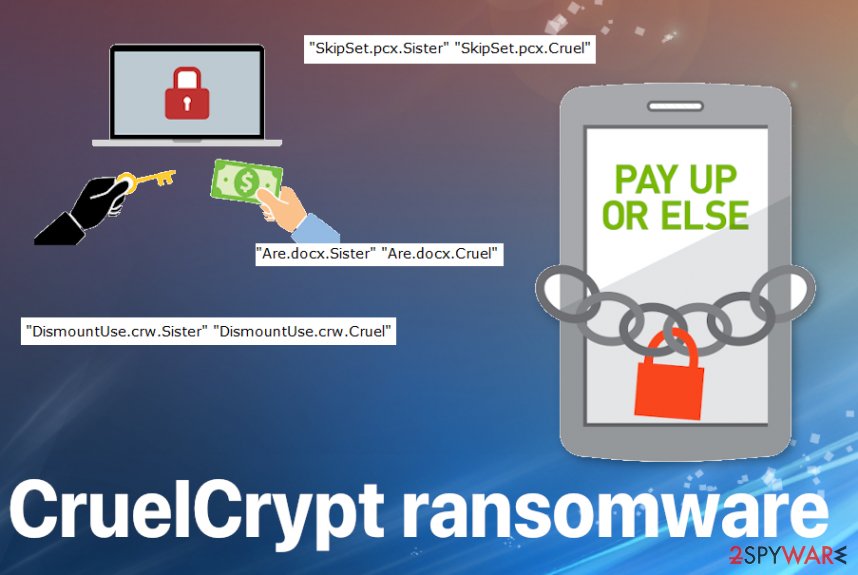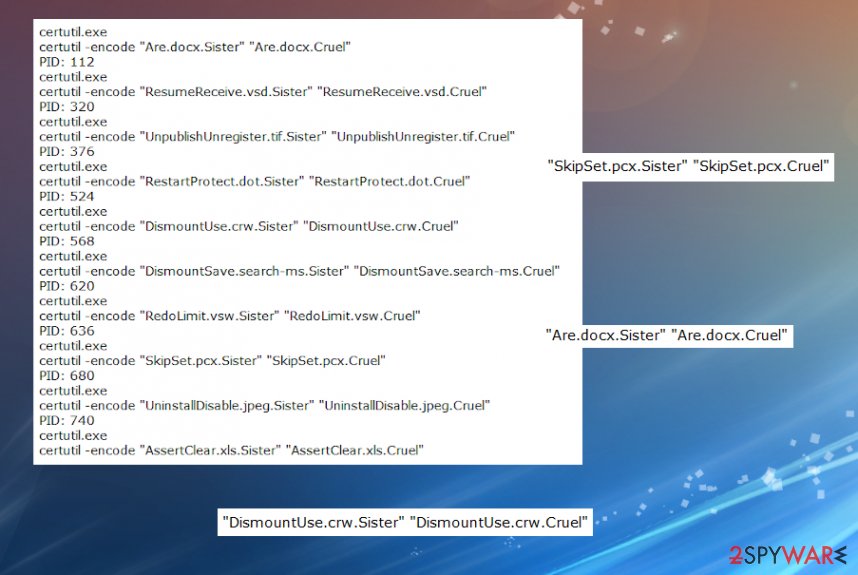CruelCrypt cryptovirus is the simpler version of the Chinese ransomware that now uses .sister and .cruel file markers for encoded data


CruelCrypt ransomware – the threat that creates frustration for users because it manages to encode various files on the machine, so there is a reason for money demands. Algorithms used for the encryption process allow to change the original code of the file, so the document, image, picture, or video, the audio file becomes useless and unopenable. Once the encryption is done, files receive the .cruel or .sister extensions and can be identified easily. However, when you cannot open the file, you cannot know what value it has for you, so there are more thoughts about paying the ransom. But this is not the option because criminals behind the threat focus on getting money from you, no matter how.
CruelCrypt ransomware virus is the version of the CXK-NMSL ransomware that was a threat popular last year. This 2020 ransomware seems to be a more basic version, that is not using the Chinese language and has fewer features that are unique. This threat may not be popular o dangerous, but there are many users who have already suffered this attack, so researchers reported the new malware and performed a full analysis.[1]
| Name | CruelCrypt ransomware |
|---|---|
| Type | Cryptovirus[2] |
| Family | CXK-NMSL ransomware |
| Ransom note | Based on the family and tendencies of the ransomware, the primary message from virus creators should appear on the desktop and in other folders with encrypted files. These text files get named readme.txt or with the particular identification of the virus family/file appendix |
| Extensions used to mark encoded files | .cruel and .sister appears at the end of the original file name and goes after the full name of the document or image and after the file-type extension |
| Distribution | The malware uses tool and injects the malicious code directly on the computer, bypasses the protection. |
| Danger | The blackmailing-based threat shouldn’t be taken lightly because of the possible results that may lead to permanent damage to your files or loss of money. Paying is not the option, but your files, system, programs can get damaged significantly when you do not remove this threat in time |
| Elimination | CruelCrypt ransomware removal is the process that shouldn’t be manual only since there are various files and programs that cryptovirus can install to trigger unwanted changes and alterations |
| Repair | There are various ways how this malware can alter your system. Adding files, programs, and other malware can significantly affect your machine. You need to not only terminate the virus, but also clear the virus damage, affected files, and corrupted software. Rely on Reimage Reimage Cleaner Intego for the job |
CruelCrypt ransomware virus uses the WriteProcessMemory function, so the CertiUtil command-line tool allows to download the malicious code into the memory and bypass windows protection. There can be some different options or variants of this threat, so the sample of the payload can be different, depending on the time it got released. The sample of the ransomware also determines the detection[3] rate when you need to get rid of the virus.
Even though the primary version of the initial version in the same virus family focused on Chinese-speaking users, CruelCrypt ransomware is targeting people with English-language based content. The sample that got analyzed when the first wave of the infection got spotted revealed that the code was written in April 2020. Files found on the system that got encrypted included the date stamp of July 30, 2019. this threat can easily spread around and affect the various systems, devices.
When the malicious processes running in the background, besides the encryption, CruelCrypt ransomware can control what functions get to be disabled or newly added on the machine. This is how the threat ensures persistence and makes the machine affected permanently.
CruelCrypt ransomware gets removal significantly more difficult because threat adds some files and disables security functions, blocks the AV tools that already run on the machine, and can lessen the data recovery options for you. Any executables, DLL files, registry entries can trigger many processes that sure of malicious activities.
Experts[4] note that it is important to ensure that those affected parts of the system and files that get corrupted are fully recovered, repaired before you restore encrypted data causing your backups or third-party software. You need to remove CruelCrypt ransomware properly with AV tool or anti-malware/security app, and then clear the damage using Reimage Reimage Cleaner Intego.
Even though this CruelCrypt virus uses different .cruel and .sister file extensions, these markers get split though all the files and all the photos, documents are unreadable once the file is encoded. It is not determined by the particular file extension. removal to repair processes is not affected by the file extension. So react tot he infection and remove the threat as soon as you can, no matter with file marker dominates on the machine.

CruelCrypt ransomware – cryptovirus that can affect the bulk of your mainly used data.

CruelCrypt ransomware – cryptovirus that can affect the bulk of your mainly used data.
You need to note that none of those tools that focus on. Cruel virus elimination can restore files affected by encryption. Data cannot get recovered by removing the ransomware itself. You need a proper decryption program that is designed to restore CruelCrypt ransomware affected files, encoded files. But file recovery is a separate procedure, that can be achieved with proper tools. We have a few options for you below, but we should note that data backups are the best.
CruelCrypt ransomware is not decryptable, and there is no official decryption program that could repair any files. You may store some malware- related files and use them later on with the decryption tool. However, the initial BAT/ CXK_NMSL ransomware is still not decryptable yet. It is more likely that the CruelCrypt virus will not get decrypted any time soon.
The threat can use malicious code droppers or spread the virus using malicious MS documents
This is the threat that is known for using a particular tool that can be used via hacked or malicious sites and trigger the injection of malicious code directly in the memory. This is one of the more stealthy virus distribution ways, but ransomware developers can easily use any of the available methods that various malicious actors rely on.
The WriteProcessMemory function writes data to the virtual memory of another process. This operation can get launched from a malicious macro-triggered process. When you receive emails with file attachments, get messages about supposed financial information, and open the attached file on the system, without a doubt, you can get the infection directly on the system.
These MS Office documents, OpenOffice, PDF, text files, databases, photos, music, video, image files, archives can contain scripts, direct malware payloads, and affect your machine significantly from the minute infiltration happens. Pay attention to senders, company names, file attachments, and be suspicious about everything, to keep the machine secure.
Remove the Cruel Crypt ransomware virus by running a proper anti-malware tool
You cannot keep this CruelCrypt ransomware virus on the system for long because this is the threat that can affect the machine significantly when it accesses system folders, files associated with some programs or parts of the software. Once crucial files get affected, you cannot repair those data recovery or security functions easily.
You should get the proper anti-malware tool and run the full system scan to remove CruelCrypt ransomware as soon as you get the ransom-demanding message on the screen. Even if you do not get the file from crypto-extortionists when the data gets encoded and marked, you need to react ASAP, so system damage is at the minimum.
CruelCrypt ransomware removal process shouldn’t be the only procedure launched on the machine. Tools like SpyHunter 5Combo Cleaner or Malwarebytes can possibly find and terminate the threat, malicious programs, or the ransomware fully. However, the procedure of system file and function remover is also crucial since the threat works in the background for a long period. Reimage Reimage Cleaner Intego and other repair utilities can find and fix files damaged by the threat.
The government has many issues in regards to tracking users’ data and spying on citizens, so you should take this into consideration and learn more about shady information gathering practices. Avoid any unwanted government tracking or spying by going totally anonymous on the internet.
You can choose a different location when you go online and access any material you want without particular content restrictions. You can easily enjoy internet connection without any risks of being hacked by using Private Internet Access VPN.
Control the information that can be accessed by government any other unwanted party and surf online without being spied on. Even if you are not involved in illegal activities or trust your selection of services, platforms, be suspicious for your own security and take precautionary measures by using the VPN service.
Computer users can suffer various losses due to cyber infections or their own faulty doings. Software issues created by malware or direct data loss due to encryption can lead to problems with your device or permanent damage. When you have proper up-to-date backups, you can easily recover after such an incident and get back to work.
It is crucial to create updates to your backups after any changes on the device, so you can get back to the point you were working on when malware changes anything or issues with the device causes data or performance corruption. Rely on such behavior and make file backup your daily or weekly habit.
When you have the previous version of every important document or project you can avoid frustration and breakdowns. It comes in handy when malware occurs out of nowhere. Use Data Recovery Pro for the system restoring purpose.
This entry was posted on 2020-06-22 at 07:43 and is filed under Ransomware, Viruses.

